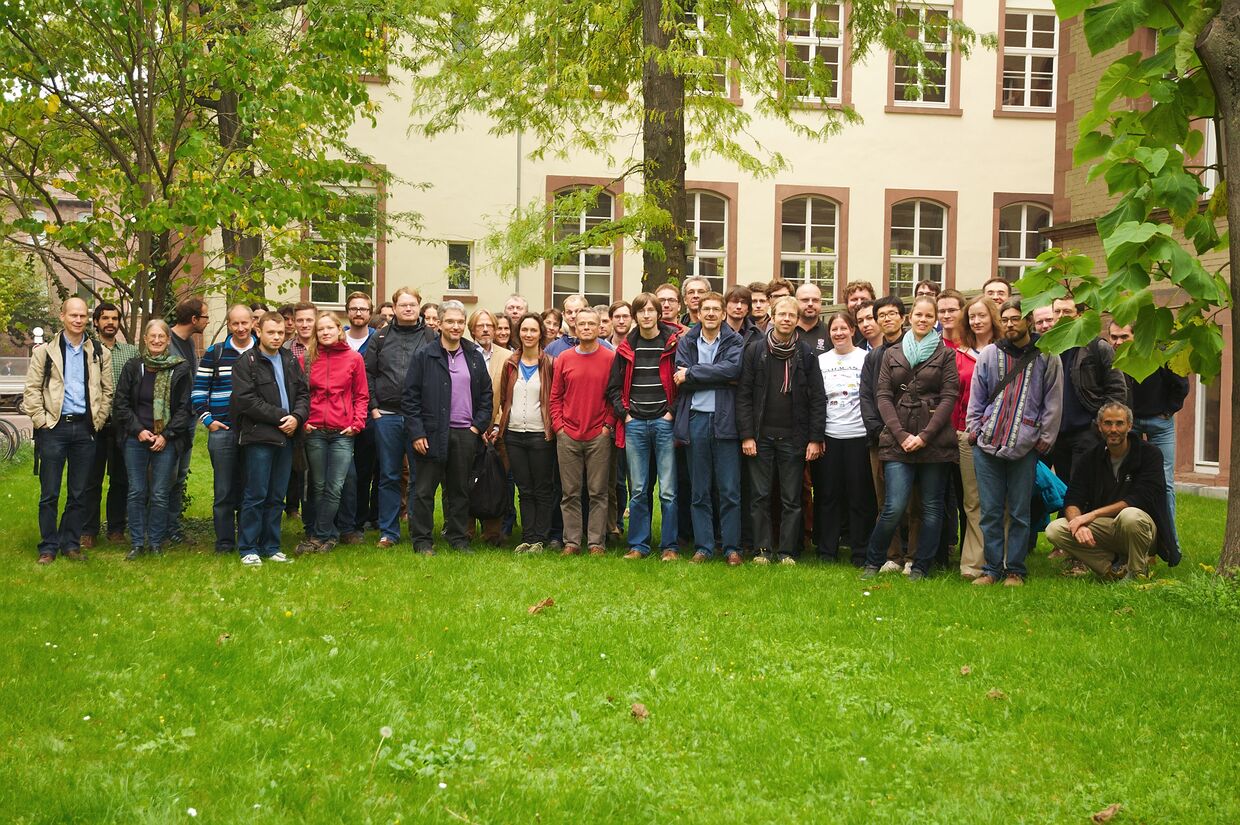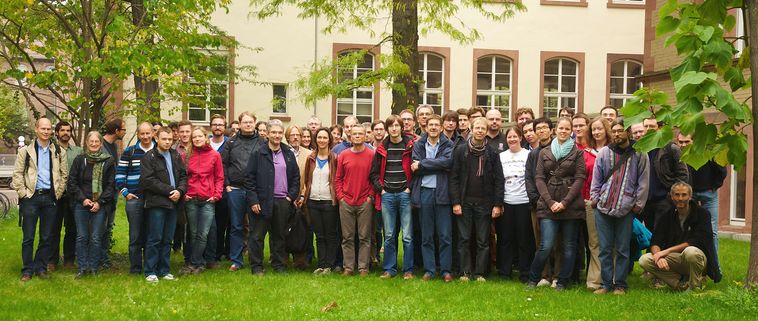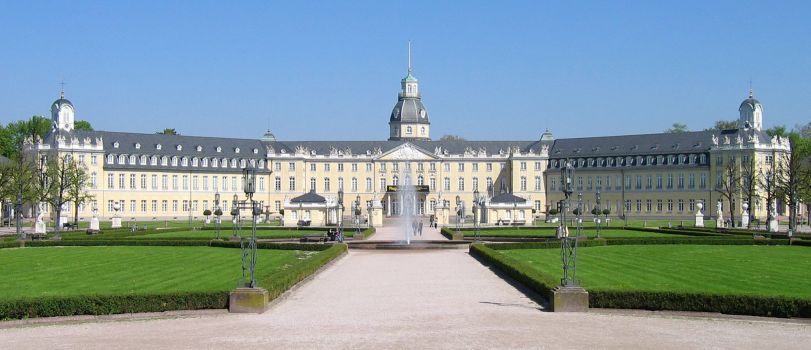GGT-Conference 2013

The conference will highlight recent advances in geometry, topology, and geometric group theory and aims at fostering communication between experts and young researchers as well as identifying new directions of further research in these fields.
Conference Picture

Speakers
Speakers include:- Uri Bader, Technion, Israel Institute of Technology
- Christoph Böhm, WWU Münster
- Marc Burger, ETH Zürich
- Thomas Farrell, Binghamton University
- Fernando Galaz-García, WWU Münster
- Ursula Hamenstädt, Universität Bonn
- Alessandra Iozzi, ETH Zürich
- Jean-François Lafont, The Ohio State University
- Anna Lenzhen, Université de Rennes 1
- Wolfgang Lück, Universität Bonn
- Gabriele Mondello, Sapienza - Università di Roma
- André Neves, Imperial College London
- Wolfgang Steimle, Københavns Universitet
- Karen Vogtmann, Cornell University
- Christopher Voll, Universität Bielefeld
- Nathalie Wahl, Københavns Universitet
- Michael Weiss, WWU Münster
Organizers
Roman Sauer, Wilderich Tuschmann, Gabriela Weitze-Schmithüsen
Program
All lectures will take place in the "Hertz-Hörsaal". The first lecture will begin on Monday, October 7th, 13:00 and the final lecture will end on Friday, October 11th, 14:00.
The coffee breaks will take place in the foyer of the "Tulla-Hörsaal".
The conference dinner will take place on Thursday evening at the "Badische Weinstuben".
View Restaurants nearby in a map.
Monday 7 October 2013
12:30 - 13:00 Registration13:00 - 13:30 Coffee break / Registration
13:30 - 14:30 Thomas Farell
14:30 - 15:00 Coffee break / Registration
15:00 - 16:00 Nathalie Wahl
16:00 - 16:30 Coffee break / Registration
16:30 - 17:30 Karen Vogtmann
Tuesday 8 October 2013
09:30 - 10:30 Fernando Galaz-García10:30 - 11:00 Coffee break
11:00 - 12:00 Anna Lenzhen
12:00 - 14:30 Lunch break
14:30 - 15:30 Jean-François Lafont
15:30 - 16:30 Coffee break
16:30 - 17:30 Christoph Böhm
Wednesday 9 October 2013
09:30 - 10:30 Marc Burger10:30 - 11:00 Coffee break
11:00 - 12:00 Uri Bader
12:00 - 12:30 Coffee break
12:30 - 13:30 Alessandra Iozzi
13:30 - 19:00 Excursion
Thursday 10 October 2013
09:30 - 10:30 Wolfgang Steimle10:30 - 11:00 Coffee break
11:00 - 12:00 Wolfgang Lück
12:00 - 14:30 Lunch break
14:30 - 15:30 Gabriele Mondello
15:30 - 16:30 Coffee break
16:30 - 17:30 Christopher Voll
19:00 - 22:00 Conference Dinner
Friday 11 October 2013
09:30 - 10:30 Michael Weiss10:30 - 11:00 Coffee break
11:00 - 12:00 Ursula Hamenstädt
12:00 - 13:00 Lunch break
13:00 - 14:00 André Neves
Abstracts
Uri Bader (Technion, Israel Institute of Technology)On an abstract notion of a rank for groups
I'll define inductively a certain class of groups. This class contains all Lie groups without a higher rank simple factor, all CAT(0) cubical complexes groups, all mapping class groups and Aut(F_n) as well as many others. I will explain how this definition is related to the abstract notion of a Weyl group and derive various rigidity results. The talk is based on a joint work with Alex Furman.
Christoph Böhm (WWU Münster)
On the long-time behavior of homogeneous Ricci flows
tba
Marc Burger (ETH Zürich)
On the volume of complex representations of hyperbolic 3-manifold groups
For a hyperbolic 3-manifold M of finite volume, we define a notion of volume for any representation of its fundamental group into SL(n,C). The definition of this invariant uses the bounded cohomology of M relative to its ends, and the construction of a cocycle defined on the set of all 4-tuples of complete flags in complex n-space. We prove a Milnor-Wood type inequality for this invariant and establish a rigidity result for representations achieving equality. This is joint work with Michelle Bucher and Alessandra Iozzi.
Thomas Farrell (Binghamton University)
Anosov bundles
I will report on recent joint work with Andrey Gogolev on Anosov bundles. These are smooth fiber bundles M --> E --> X whose fibers are equipped with either an Anosov diffeomorphism or an Anosov flow. (Here the fiber M is a closed smooth manifold and the structure group is Diff(M).) We give examples of non-trivial bundles which are Anosov and also show, under quite general conditions, that Anosov bundles are topologically trivial. One application of this work is to shed light on the following: Conjecture (Farrell-Ontaneda). Every negatively curved bundle with simply connected base space is topologically trivial. A negatively curved bundle is one where each fiber is equipped with a negatively curved Riemannian metric.
Fernando Galaz-García (WWU Münster)
Singular Riemannian foliations by aspherical manifolds
Isometric actions of compact Lie groups on complete Riemannian manifolds are examples of singular Riemannian foliations. We will discuss the structure of the fundamental group of the regular leaves of a closed singular Riemannian foliation on a compact, simply connected Riemannian manifold. We will then talk about the structure and classification of singular Riemannian foliations whose leaves are homeomorphic to closed aspherical manifolds, generalizing isometric torus actions. This is joint work with Marco Radeschi.
Ursula Hamenstädt (Universität Bonn)
Surface subgroups for rank one locally symmetric manifolds
We explain how the program of Kahn and Markovic for constructing surface subgroups of fundamental groups of hyperbolic 3-manifolds can be extended to construct almost totally real incompressible surfaces in arbitrary closed rank one locally symmetric spaces. If time permits, we indicate some applications.
Alessandra Iozzi (ETH Zürich)
Bounded cohomology in non-positive curvature
We illustrate how bounded cohomology with coefficients can be used to prove rigidity theorems for groups acting on non-positively curved spaces, among which CAT(0) cube complexes.
Jean-François Lafont (The Ohio State University)
Examples of exotic aspherical spaces
There are two well-known methods for producing exotic non-positively curved spaces. The first is via the hyperbolization technique of Davis-Januszkiewicz. The second is via the Davis complex associated to certain Coxeter groups. I will illustrate these techniques by presenting some recent constructions of spaces having various exotic properties.
Anna Lenzhen (Université de Rennes 1)
Thurston metric on Teichmuller space
Thurston metric (also called Lipschitz metric) is an asymmetric metric defined by considering Lipschitz maps between hyperbolic surfaces. I will give an overview of what is known about this metric, and then focus on studying its geodesics. Joint work with Kasra Rafi and Jing Tao.
Wolfgang Lück (Universität Bonn)
Hyperbolic groups with spheres as boundary
Let G be a torsion-free hyperbolic group and let n greater or qual to 6 be an integer. We prove that G is the fundamental group of a closed aspherical manifold M if the boundary of G is homeomorphic to an (n-1)-dimensional sphere, and in this case M is unique up to homeomorphism.
Gabriele Mondello (Sapienza - Università di Roma)
Abelian differentials on curves of genus 3 and beyond
The moduli space of curves endowed with a nonzero Abelian differential is naturally stratified according to the configuration of zeroes of the differential. In general, such strata are topologically and geometrically interesting though mysterious. For instance, Kontsevich and Zorich raised the problem of whether such strata are K(G,1). We will provide a description of all strata in genus 3, which allows to partially answer such conjecture. We will also sketch an approach for the smallest strata in higher genus. This is joint work with Eduard Looijenga.
André Neves (Imperial College London)
Min-max in Geometry (Joint with Fernando Marques).
I will survey many of the results proven by min-max in geometry and announce some new results I have with Fernando concerning the existence of minimal hypersurfaces.
Wolfgang Steimle (Københavns Universitet)
The space of positive scalar curvature metrics
Our understanding of the space $R^+(M)$ of metrics of positive scalar curvature on a spin manifold $M$ has recently improved. The goal of this talk is to construct specific interesting families of metrics of positive scalar curvature on spin manifolds $M$ of high dimension. This leads to elements of infinite order in the higher homotopy and homology groups of $R^+(M)$. If $M$ is a sphere, then these elements remain non-trivial (and of infinite order) in the "observer moduli space". Along the way we construct examples of smooth fiber bundles over spheres whose total spaces have non-vanishing $\hat{A}$-genera. This is joint work with B. Hanke and Th. Schick.
Karen Vogtmann (Cornell University)
An outer space for right-angled Artin groups
Right-angled Artin groups interpolate between free groups and free abelian groups, and one may view their outer automorphism groups as interpolating between Out(F_n) and GL(n,Z). After summarizing what is known about these automorphism groups I will explain how to build contractible spaces on which they act properly. For free abelian groups this is the usual symmetric space with its GL(n,Z) action, and for free groups this is Outer space, with its action of Out(F_n).
Christopher Voll (Universität Bielefeld)
Representation growth of groups
The study of representation growth of groups aims to understand the distributions of the numbers of irreducible, finite-dimensional representations of groups. For important classes of groups, such as certain arithmetic groups, Dirichlet generating functions are an appropriate tool to study these numbers. For arithmetic groups satisfying the Congruence Subgroup Property these representation zeta functions have Euler products, indexed by places of number fields. Powerful tools from geometric representation theory (viz.\ the Kirillov orbit method) and algebraic geometry (such as $p$-adic integration) are available to study both the individual factors and the analytic properties of their Euler products. I will survey some recent results on representation zeta functions, and explain their implications for representation growth of arithmetic groups.
Nathalie Wahl (Københavns Universitet)
Homological stability for automorphism groups
We present a general framework for families of groups satisfying homological stability, which encompasses the "old examples" from braid groups to general linear groups, via automorphism groups of free groups and mapping class groups, as well as potential new examples.
Michael Weiss (WWU Münster)
Homotopy theory of spaces of smooth embeddings via manifold calculus and operads
In manifold calculus applied to smooth embeddings from M to N, we try to understand a smooth embedding f from M to N by restricting it to finite subsets of the source M. (We try some variations of this as well to capture tangential data.) Although this scheme has been in place for 15 years at least, recent efforts to clarify it by organizing the space of finite subsets of a manifold (the disjoint union of all its configuration spaces) into a topological category or an operad-like structure, often along well-known lines, have been very successful and have added much depth to it. To illustrate that I plan to talk around a theorem due to Arone-Turchin with an improvement by Dwyer-Hess and probably another improvement by Boavida Brito and myself. This theorem describes the space of smooth neat embeddings from an m-disk to an n-disk (embeddings prescribed on the boundary of the m-disk, in the obvious way) in mostly operadic terms, assuming the codimension n-m is at least 3. Our own contribution is to insist on friendly relations between the linear algebra which we see when we linearize a smooth embedding near a point of the source, and the more combinatorial information which we see when we restrict a smooth embedding to a finite subset of the source.
Registration
Registration is closed. The deadline was September 1st.
Accomodation
Non-speakers are asked to organize their accomodation themselves. We recommend staying at the guest house of the KIT, the"Gastdozentenhaus". It is located on the campus, close to the lecture rooms and the castle. Other hotels can be found on the website of the Karlsruhe Tourist Information.
If you have any questions or encounter any problems please feel free to contact Christine Fehrle.
Getting there
View GGT-Conference 2013 in a larger map

Math Institute (Allianzgebäude) Tulla-Hörsaal Hertz-Hörsaal
Contact
If you have any questions, please feel free to contact our secretary Christine Fehrle or one of the organizers:
Christine Fehrle | e-mail
Tel.: +49 721 608-42059
Fax: +49 721 608-42148
Institut für Algebra und Geometrie
Kaiserstr. 89-93
D-76133 Karlsruhe
Roman Sauer | e-mail
Wilderich Tuschmann | e-mail
Gabriela Weitze-Schmithüsen | e-mail

